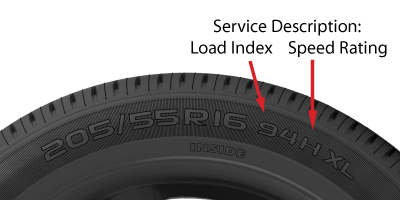Last Updated on April 21, 2024
Navigate Tire Selection Like a Pro with Insights into the Tire Speed Index
Unlocking the Power of the Tire Speed Index: Your Road to Safer Driving
When it comes to choosing the right tires for your vehicle, it’s not just about size, brand, or tread pattern. There’s another crucial factor that often goes overlooked but plays a significant role in your safety and driving experience: the tire speed index.
This comprehensive guide will dive deep into tire speed ratings and why they matter more than you might think. Whether you’re a seasoned driver or a new road enthusiast, understanding the tire speed index will empower you to make informed decisions when it’s time to replace your tires.
Why Does the Tire Speed Index Matter?
Let’s start by demystifying the tire speed index. Essentially, a code on your tire’s sidewall indicates the maximum speed your tires can safely handle. This rating isn’t just for high-speed racers; it matters for everyday drivers, too.
Imagine you’re cruising down the highway at 70 mph, and suddenly, you need to make an emergency maneuver or hit the brakes hard. Your tires play a critical role in maintaining control and ensuring your safety. If your tires aren’t rated for your driving speed, it can lead to a loss of control, reduced braking performance, and increased risk of accidents.
Cracking the Code: Understanding Tire Speed Ratings
The tire speed index indicates the top speed your tires can handle. Every tire has a designation indicating the top speed at which the tire can properly operate. This designation originated from the German Autobahn; due to the lack of posted maximum speed limits, tires needed to indicate their performance speeds to keep drivers safe. Now, all tires manufactured have this designation.
Here is a chart that shows how the speed ratings work; note that the higher the speed rating, the shorter the tire’s life cycle. You sacrifice longevity if you want a tire to perform at top speeds.
Tire speed ratings are represented by a letter, often following the tire’s load index. These letters correspond to specific speeds in kilometers per hour (km/h) and miles per hour (mph). The higher the letter in the alphabet, the higher the speed rating.
Here’s a quick overview of some common speed ratings:
- Q (99 mph): Suitable for subcompact cars and sedans.
- H (130 mph): Found on most passenger cars and SUVs.
- V (149 mph): Common on high-performance and sports cars.
- W (168 mph): Typically seen on sports cars and supercars.
- Y (186 mph): Reserved for ultra-high-performance and exotic vehicles.
The tire speed index letter is typically in the Service Description area; see the graphic below. However, for Z-rated tires, the designation will be in front of the R, such as 225/50ZR16. Also, with Z-rated tires, a second letter in the service description area will indicate how high a tire can perform above the Z rating. W indicates the tire can perform above 149 mph and up to 168 mph; a Y indicates above 149 mph and up to 186 mph.
The service description combines the load index and the speed rating. Next, we will talk about the load index.
Why You Should Care About the Tire Speed Index
Now that you know what those letters on your tire sidewall mean, let’s explore why the tire speed index should be on your radar:
1. Safety First
Your safety and the safety of your passengers should always be your top priority. Choosing tires with an appropriate speed rating ensures your vehicle’s handling and braking capabilities are optimized for your driving conditions.
2. Performance Matters
Tires with higher speed ratings often offer better handling and responsiveness. If you enjoy spirited driving or want more control over your vehicle, investing in higher-rated tires can significantly enhance your driving experience.
3. Legal Requirements
In some regions, it’s a legal requirement to have tires with a speed rating equal to or higher than your vehicle’s top speed. Failing to comply with these regulations can result in fines or penalties.
4. Maintaining Warranty
If your vehicle comes equipped with high-performance tires, replacing them with tires of a lower speed rating might void your manufacturer’s Warranty. Always check your owner’s manual for guidance.
Finding the Right Tires for You
Now that you understand the importance of the tire speed index, it’s time to put this knowledge into action when buying new tires. Here are some steps to help you make the right choice:
- Check Your Vehicle’s Specifications: Refer to your owner’s manual or consult your manufacturer’s recommendations for the appropriate tire speed rating.
- Consider Your Driving Habits: Think about your typical driving scenarios. Do you primarily drive on highways or enjoy spirited driving? Your choice should align with your driving style.
- Consult the Experts: Don’t hesitate to contact tire professionals who can guide you based on your vehicle, driving habits, and local conditions.
- Explore Your Options: Tire Easy offers a wide range of tires with various speed ratings. Please browse our selection to find the perfect fit for your needs.
Conclusion
In conclusion, the tire speed index is a critical factor that should never be underestimated regarding your vehicle’s safety and performance. Understanding this rating empowers you to make informed decisions about your tires, ensuring they match your driving habits and vehicle specifications well.
Whether you’re a daily commuter or a weekend adventurer, choosing the right tire speed index is key to a safer and more enjoyable driving experience. At Tire Easy, we prioritize your safety and satisfaction. With our wide selection of tires featuring various speed ratings, finding the perfect match for your needs has never been easier.
Ready to Upgrade Your Tires?
Elevate your driving experience and prioritize safety by selecting the right speed-rating tires. At Tire Easy, we’re committed to helping you find the perfect tires for your vehicle. Explore our extensive collection of high-quality tires and take the first step towards safer and more enjoyable journeys.
Don’t compromise on safety – invest in tires with the appropriate speed index and enjoy the peace of mind of driving confidently on the road. Your journey begins with the right tires, so shop with us today and elevate your driving experience!
Upgrade your tires today and experience the difference of driving with confidence. Your safety is worth it!
Shop Now and Drive Safely with Tire Easy!
FAQs
How do I know what speed rating I need for my tires?
The appropriate speed rating for your tires depends on your vehicle and driving habits. You can usually find the recommended speed rating in your vehicle’s owner’s manual or the tire placard in the door jamb or glove compartment. If you’re unsure, consult with a tire professional for guidance.
Does the tire speed index matter?
The tire speed index is crucial because it indicates the maximum safe speed at which the tire can carry a load under ideal conditions. Choosing the right speed rating ensures your tires can handle the speeds you typically drive, contributing to your safety on the road.
What is the speed index on a tire?
The speed index, also known as the tire speed rating, is a letter code found on the sidewall of a tire. It represents the maximum speed the tire can safely maintain for an extended period. For example, “H” corresponds to a maximum speed of 130 mph (210 km/h).











